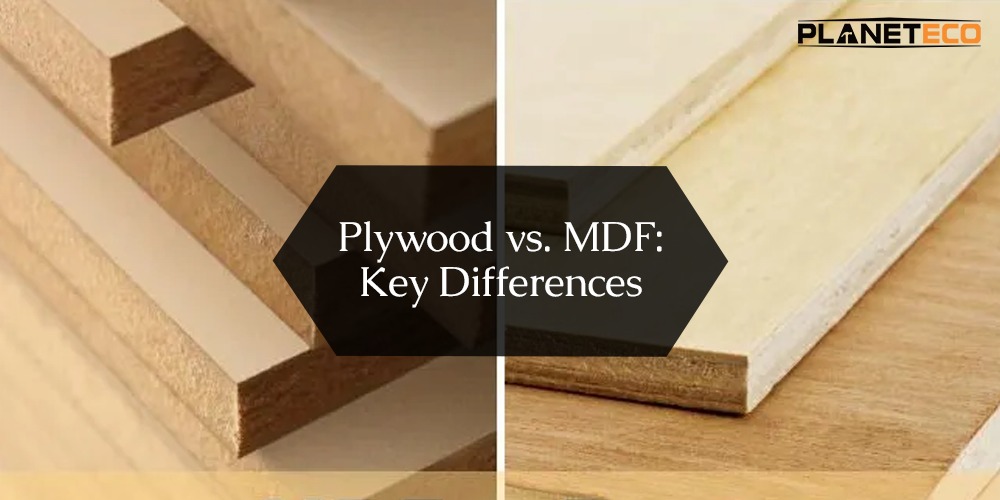If you’ve ever tackled a DIY furniture project or studied construction materials, you’ve likely struggled with two popular choices: plywood and MDF (medium-density fiberboard). But how do you know which one is more suitable for your project? Should you opt for the sturdy layers of plywood or the smooth surface of MDF?
Let’s simplify the key differences with clear insights from Planeteco.
What is Plywood?
Definition and Composition
Plywood is made from multiple thin layers, or veneers, of real wood that are glued together. Each veneer layer is placed with its grain at a right angle to the one before it, creating a strong, stable material.
Types of Plywood
- Softwood plywood: Great for construction, roofing, and subflooring.
- Hardwood plywood: Ideal for furniture, cabinets, and decorative projects.
- Marine plywood: Perfect for moisture-heavy environments.
What is MDF?
Definition and Composition
MDF, or medium-density fiberboard, is an engineered wood product made by breaking down wood into fibers, mixing it with resin, and pressing it into flat panels under heat and pressure.
Types of MDF
- Standard MDF: General-purpose, ideal for interior furniture and shelving.
- Moisture-resistant MDF: Suitable for kitchens and bathrooms.
- Fire-retardant MDF: Great for commercial buildings requiring fire safety compliance.
Strength and Durability
Plywood Strength
Plywood’s cross-layered construction provides high strength and resistance to warping, cracking, or shrinking, even under heavy loads.
MDF Strength
MDF has constant power, but it’s not as resilient under heavy loads and can sag or deform with prolonged weight.
Which is More Durable?
Naturally, plywood wins the durability battle. Its layered structure handles stress better and is more resistant to structural issues over time. For eco-conscious durability, Planet Eco often recommends plywood for structural applications.
Moisture Resistance
Plywood and Moisture
Standard plywood resists moisture fairly well, and marine plywood offers excellent water resistance. It’s often chosen for outdoor and humid conditions.
MDF and Moisture
Standard MDF absorbs moisture easily and tends to swell or break down. Moisture-resistant MDF exists but still isn’t suitable for prolonged outdoor exposure.
Workability and Machining
Working with Plywood
Plywood is easy to cut and drill but can splinter. Sharp tools and slower cutting speeds help maintain clean edges.
Working with MDF
MDF is very machinable, producing smooth boundaries and surfaces without splintering. Yet, it creates fine dust, necessitating safety precautions.
Surface Finish
Surface Characteristics of Plywood
Plywood’s grainy surface is attractive but might require sanding and finishing to smooth imperfections.
Surface Characteristics of MDF
MDF provides a smooth, flawless surface ideal for painting and veneering without extensive preparation.
Cost Comparison
Plywood Costs
Plywood typically costs more due to the quality of materials and complex manufacturing processes.
MDF Costs
MDF is less expensive, making it budget-friendly for large-scale projects or furniture items.
Weight Comparison
Plywood Weight
Plywood is lighter in weight, making it easier to handle and transport, particularly in large sheets.
MDF Weight
MDF tends to be thicker and heavier, which can make handling and installation challenging.
Environmental Impact
Eco-Friendliness of Plywood
Plywood is often more environmentally friendly, especially when sourced sustainably, as it utilizes thin wood layers efficiently.
Eco-Friendliness of MDF
MDF uses wood fibers from recycled sources but often contains formaldehyde-based resins, raising some environmental concerns. Planeteco promotes low-emission MDF variants to minimize environmental impact.
Uses and Applications
Best Uses for Plywood
- Exterior furniture
- Cabinetry
- Flooring and roofing
- Structural projects
Best Uses for MDF
- Interior furniture
- Decorative moldings
- Shelving units
- Painted furniture and cabinetry
Maintenance and Care
Caring for Plywood
Plywood requires occasional refinishing, sealing, or painting to maintain its durability, especially outdoors.
Caring for MDF
MDF needs minimal maintenance indoors, but moisture protection and avoiding water exposure are critical.
Pros and Cons Overview
Pros and Cons of Plywood
Pros: Strong, durable, moisture-resistant, versatile.
Cons: Can splinter, higher cost, requires finishing.
Pros and Cons of MDF
Pros: Smooth finish, budget-friendly, easy to machine.
Cons: Poor moisture resistance, heavy, less durable.
How to Choose Between Plywood and MDF
Consider your project’s needs—strength, moisture exposure, budget, aesthetics, and ease of handling. For outdoor, structural, or heavy-duty tasks, plywood is superior. MDF excels in indoor, decorative, or budget-sensitive projects. At Planeteco, we guide customers based on long-term project needs and environmental responsibility.
Conclusion
Understanding the differences between plywood and MDF helps you choose the right material for your specific needs. Whether prioritizing strength and durability or cost-effectiveness and surface smoothness, both materials offer distinct advantages. Evaluate your project goals clearly to make the best choice.

